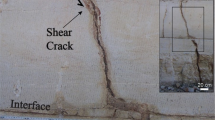Abstract
Hertzian fracture tests were conducted using an Instron on Pyrex glass specimens with various surface conditions, including lubricants, employing steel, Al2O3, WC and Pyrex glass indentors of 0.79 to 12.7 mm radius under ambient air and high vacuum environments at cross-head speeds of 8.5×10−6 to 2.1×10−4m sec−1. The results were not in strict accord with Auerbach's law, nor any of the existing energy-balance Hertzian fracture theories. Rather, they indicated that surface roughness and friction modified the Hertz stress field so that the maximum tensile stress at the surface occurred outside the contact circle. Further, they indicated that Hertzian fracture occurred by the direct, unstable growth into a cone crack of a pre-existing flaw at the displaced site of the maximum tensile stress, the flaw size responsible for the fracture decreasing with decrease in ball size (contact radius). Once a cone crack occurred, its length and growth were described reasonably well by Roesler's theory; however, his constant appears to be too high by a factor of about 5. A surface energy of @ 4 J m−2 was derived from bend tests on specimens similar to those used in the Hertzian fracture tests. Using this value, the crack sizes which lead to fracture were estimated to range between 0.6 and 3.5 μm for the conditions investigated here. The increase in the critical load for Hertzian fracture with indentation velocity was concluded to be due to kinetic effects of water vapour acting at the tip of the crack.
Similar content being viewed by others
References
H. Hertz, J. Reine Angew. Math. 92 (1881) 156; Vehandlungen des Vereins zur Beforderung des Gewerbe Fleisses, 61 (1882) 449; reprinted in English, “Hertz's Miscellaneous Papers” (MacMillan, London, 1896) ch. 5 and 6.
F. Auerbach, Ann. Phys. Chem. 43 (1891) 61.
F. C. Roesler, Proc. Phys. Soc. 69B (1956) 981.
F. C. Frank and B. R. Lawn, Proc. Roy. Soc. 299A (1967) 291.
B. R. Lawn, J. Appl. Phys. 39 (1968) 4828.
F. B. Langitan and B. R. Lawn, ibid 40 (1969) 4009.
Idem, ibid 41 (1970) 3357.
F. C. Roesler, Proc. Phys. Soc. 69B (1956) 981.
T. R. Wilshaw, J. Phys. 4 (1971) 1567.
A. G. Mikosza and B. R. Lawn, J. Appl. Phys. 42 (1971) 5540.
M. Swain, T. Williams, B. Lawn and T. Beek, J. Mater. Sci. 8 (1973) 1153.
B. R. Lawn and R. Wilshaw, ibid 10, (1975) 1049.
A. G. Evans and T. R. Wilshaw, Acta. Met. 24 (1976) 939.
A. S. Argon, Proc. Roy. Soc. 250A (1959) 472.
J. P. A. Tillett, Proc. Phys. Soc. London Sect. B 60 (1956) 55.
H. L. Oh and I. Finnie, J. Mech. Phys. Solids 18 (1967) 401.
B. Hamilton and H. Rawson, ibid 18 (1970) 127.
J. S. Nadeau and A. S. Rao, J. Canad. Ceram. Soc. 41 (1972) 63.
J. S. Nadeau, J. Amer. Ceram. Soc. 56, (1973) 467.
A. S. Argon, Y. Haril and E. Orowan, ibid 43 (1960) 86.
J. P. Andrews, Phys. Soc. London 75 (1970) 697.
J. J. Benbow, ibid 75 (1960) 697.
J. Lu, Y. Chen, G. Sargent and H. Conrad, unpublished research, University of Kentucky (1977).
S. M. Wiederhorn, J. Amer. Ceram. Soc. 52 (1969) 99.
W. F. Adler, Air Force Materials Lab. Rept. no. 4, F. 33615-73-C-5057 May (1975).
C. J. Culp, J. Soc. Glass Technol. 41 (1957) 157.
K. L. Johnson, J. J. O'connor and A. C. Woodward, Proc. Roy. Soc. London A293 (1972) 710.
D. R. Gilroy and W. Hirst, Brit. J. Appl. Phys. (J. Phys. D.) Ser. 2 2 (1969) 1784.
Sally D. Scaptura, Corning Co, private communication (1978).
T. C. Baker and F. W. Preston, J Appl. Phys. 17 (1945) 170,179.
R. J. Charles, ibid 29 (1958) 1554.
R. E. Mould, J. Amer. Ceram. Soc. 44 (1961) 481.
A. G. Evans, ibid 56 (1973) 405.
A. K. Lyle, “Glass Compositions”, Handbook of Glass Manufacturing, Vol. 1, edited by F. V. Tooley (Ogden, New York) (1974) p. 3.
Author information
Authors and Affiliations
Rights and permissions
About this article
Cite this article
Conrad, H., Keshavan, M.K. & Sargent, G.A. Hertzian fracture of Pyrex glass under quasi-static loading conditions. J Mater Sci 14, 1473–1494 (1979). https://doi.org/10.1007/BF00549324
Received:
Accepted:
Issue Date:
DOI: https://doi.org/10.1007/BF00549324




